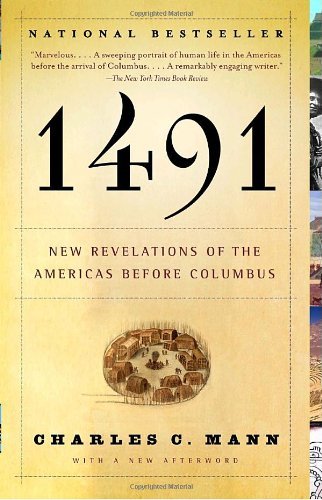1491 is not so much the story of a year, as of what that year stands for: the long-debated (and often-dismissed) question of what human civilization in the Americas was like before the Europeans crashed the party. The history books most Americans were (and still are) raised on describe the continents before Columbus as a vast, underused territory, sparsely populated by primitives whose cultures would inevitably bow before the advanced technologies of the Europeans. For decades, though, among the archaeologists, anthropologists, paleolinguists, and others whose discoveries Charles C. Mann brings together in 1491, different stories have been emerging. Among the revelations: the first Americans may not have come over the Bering land bridge around 12,000 B.C. but by boat along the Pacific coast 10 or even 20 thousand years earlier; the Americas were a far more urban, more populated, and more technologically advanced region than generally assumed; and the Indians, rather than living in static harmony with nature, radically engineered the landscape across the continents, to the point that even "timeless" natural features like the Amazon rainforest can be seen as products of human intervention. Mann is well aware that much of the history he relates is necessarily speculative, the product of pot-shard interpretation and precise scientific measurements that often end up being radically revised in later decades. But the most compelling of his eye-opening revisionist stories are among the best-founded: the stories of early American-European contact. To many of those who were there, the earliest encounters felt more like a meeting of equals than one of natural domination. And those who came later and found an emptied landscape that seemed ripe for the taking, Mann argues convincingly, encountered not the natural and unchanging state of the native American, but the evidence of a sudden calamity: the ravages of what was likely the greatest epidemic in human history, the smallpox and other diseases introduced inadvertently by Europeans to a population without immunity, which swept through the Americas faster than the explorers who brought it, and left behind for their discovery a land that held only a shadow of the thriving cultures that it had sustained for centuries before. --Tom Nissley A 1491 Timeline Europe and Asia Dates The Americas 25000-35000 B.C. Time of paleo-Indian migration to Americas from Siberia, according to genetic evidence. Groups likely traveled across the Pacific in boats. Wheat and barley grown from wild ancestors in Sumer. 6000 5000 In what many scientists regard as humankind's first and greatest feat of genetic engineering, Indians in southern Mexico systematically breed maize (corn) from dissimilar ancestor species. First cities established in Sumer. 4000 3000 The Americas' first urban complex, in coastal Peru, of at least 30 closely packed cities, each centered around large pyramid-like structures Great Pyramid at Giza 2650 32 First clear evidence of Olmec use of zero--an invention, widely described as the most important mathematical discovery ever made, which did not occur in Eurasia until about 600 A.D., in India (zero was not introduced to Europe until the 1200s and not widely used until the 1700s) 800-840 A.D. Sudden collapse of most central Maya cities in the face of severe drought and lengthy war Vikings briefly establish first European settlements in North America. 1000 Reconstruction of Cahokia, c. 1250 A.D.* Abrupt rise of Cahokia, near modern St. Louis, the largest city north of the Rio Grande. Population estimates vary from at least 15,000 to 100,000. Black Death devastates Europe. 1347-1351 1398 Birth of Tlacaélel, the brilliant Mexican strategist behind the Triple Alliance (also known as the Aztec empire), which within decades controls central Mexico, then the most densely settled place on Earth. The Encounter: Columbus sails from Europe to the Caribbean. 1492 The Encounter: Columbus sails from Europe to the Caribbean. Syphilis apparently brought to Europe by Columbus's returning crew. 1493 Ferdinand Magellan departs from Spain on around-the-world voyage. 1519 Sixteenth-century Mexica drawing of the effects of smallpox** Cortes driven from Tenochtitlán, capital of the Triple Alliance, and then gains victory as smallpox, a European disease never before seen in the Americas, kills at least one of three in the empire. 1525-1533 The smallpox epidemic sweeps into Peru, killing as much as half the population of the Inka empire and opening the door to conquest by Spanish forces led by Pizarro. 1617 Huge areas of New England nearly depopulated by epidemic brought by shipwrecked French sailors. English Pilgrims arrive at Patuxet, an Indian village emptied by disease, and survive on stored Indian food, renaming the village Plymouth. 1620 *Courtesy Cahokia Mounds State Historic Site, Collinsville, Ill., painting by Michael Hampshire. **Courtesy Museum of Indian Arts and Culture, Santa Fe, N.M. (Bernardino de Sahagún, Historia General de las Cosas de Nueva España, 1547-77).
